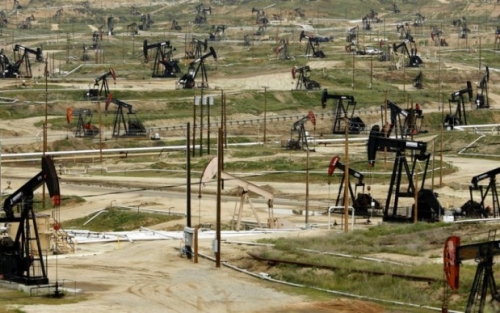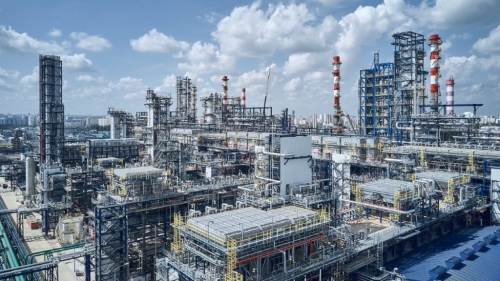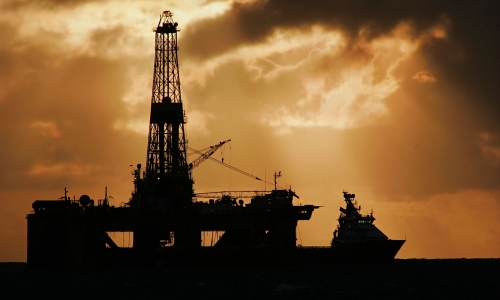Oil prices rose for the week following multiple drone attacks that suspended loadings from the largest port in western Russia, but gains were capped by concerns of potential surplus in the coming months as well as weaker U.S. demand risk.
BKR Rig Count | The total active drilling rigs in the United States increased by 2 last week to 539. Oil rigs increased by 2 at 416, and gas rigs stayed flat at 118. Rig count in the Permian Basin remained flat at 254 | Sept 12 | BKR NAM Rig Count
US Crude Inventories, excluding those in the Strategic Petroleum Reserve (SPR), increased by 3.9 MMbbl to 424.6 MMbbl (about 3% below the 5y average for this time of year). On the products side, gasoline increased by 1.5 MMbbl (at the 5y average for this time of year). Distillate fuels increased by 4.7 MMbbl (9% below the 5y average). Total commercial petroleum inventories increased by 15.4 MMbbl | Sept 5 | EIA Weekly Report
OPEC+ Knows Its Oil Production Increases Aren’t All They Seem. OPEC+ delegates expect that roughly half the advertised volume will be delivered, as some members atone for earlier overproduction and others — beset by either financial constraints or international sanctions — struggle to increase. Adjusting for pledges to compensate for prior oversupply and looking at capacity limits some countries face, the nine nations may only add 1.15 million of the advertised 1.66 million. OPEC+ holds more than 3 million barrels a day of spare production capacity, with the bulk concentrated in Saudi Arabia, the UAE and Iraq. Reviving the 1.66 million-barrel tranche would enable them to add 730,000 barrels a day. While the others would be allowed to add about 800,000 a day, they lack the spare capacity needed to boost supplies that much | Sept 9 | Bloomberg
Oil Jumps After Drones Strike Russian Terminal. The drone attack on Russia's northwestern port of Primorsk, one of the country's largest oil and fuel export terminals, led to a suspension of oil loading operations overnight, an official from Ukraine's SBU security service said. "Those attacks on Russian energy infrastructure have room to drag down Russian crude and refined product exports," UBS analyst Giovanni Staunovo said. The Kremlin said on Friday there was a pause in peace negotiations between Russia and Ukraine | Sept 12 | Reuters
Bakken Oil Output Shows Signs of Slowing as Pipeline Flows Slip. The Dakota Access Pipeline carried about 542,000 barrels of oil a day in August, down from 566,000 in July and a 2025 high of 588,000 in January, according to Wood Mackenzie. Production from the Bakken had been expected to rise heading into late 2025 and early 2026 but weaker oil prices and rising competition from Canada have contributed to slower drilling in the region | Sept 11 | Bloomberg
Sanctioned Russian Liquefied Natural Gas Shipments Increasingly Making their Way to China, Bringing an “important change” to the global trade of the fuel. After three cargoes from the US-banned Arctic LNG 2 plant landed at China’s Beihai terminal over the past two weeks, the world’s top commodities trading house sees as many as 10 to 13 shipments a month going to the Asian nation, Pablo Galante Escobar, head of LNG at Vitol, said. The shipments come at a time when China is already ramping up imports of Russian gas arriving via the Power of Siberia pipeline. China competes with Europe for cargoes in the global LNG market, and its purchases from Russia could potentially ease demand for supplies from major exporters like the US and Qatar | Sept 10 | Bloomberg
China Plans to More than Double its Energy Storage Capacity in the Next Two Years to further accelerate the deployment of renewables. The country aims to have more than 180 gigawatts of battery capacity by 2027, which should drive an investment of $35.1 billion, according to a work plan issued by the National Development and Reform Commission and the National Energy Administration for the period between 2025 and 2027 | Sept 11 | Bloomberg
Argentina’s oil and gas exports are set to be twice the volume of domestic demand within four years, YPF chief executive Horacio Marin said. The shift toward export-led growth is being driven by improved economic conditions in the country, new laws supporting investment and a surge in infrastructure spending. “All the Vaca Muerta development from now on is for export,” he said. “In four years, exports will be twice the internal market” | Sept 12 | Upstream
North America
NextDecade reached a positive FID for Train 4 at its Rio Grande LNG project in the US, expected to produce approx. 6 MTPA of LNG for total estimated production capacity of 24 MTPA. Train 4 is supported by 4.6 MTPA of 20-year LNG SPAs with ADNOC, TotalEnergies, and Aramco. Substantial completion is anticipated in the second half of 2030. The company also executed a 20-year LNG SPA with ConocoPhillips for purchase of 1.0 MTPA of LNG for 20 years from Rio Grande LNG Train 5. NextDecade announced a total of 4.5 MTPA of LNG from Train 5 sold under 20-year LNG SPAs, which it believes is sufficient to support a positive FID on Train 5 in the fourth quarter of 2025 | Sept 8 | S&P, NEXT PR, NEXT PR
Independent Murphy Oil has reiterated that its growth will come primarily from offshore exploration with West Africa, the US Gulf and South America in its line of sight. The company’s chief executive Eric Hambly emphasized that exploration has been “the life of our company over the last 100 years”. Murphy Oil’s current hotspots for large opportunities are the Ivory Coast and Vietnam | Sept 12 | Upstream
Europe & Africa
Shell's Victory gas field in the UK, P2596 (block 207/1a), WD 158m, West of Shetlands, is expected to start production via the Greater Laggan Area (GLA) infrastructure, with production to then be transported to the Shetland Gas Plant near Sullom Voe . The single well development is expected to produce 148.6 MMcfg/d and 115 bc/d at peak | Sept 12 | S&P
Saipem signed an EPCI contract with TPAO (op) for flowlines and an export pipeline for Phase 3 of the Sakarya gas development project, deepwater West Black Sea, Turkiye. Scope includes eight rigid flowlines and a 24”, 183 km export pipeline at depths up to 2,200 m. Production will start via the FPU at a rate of 25 MMcm/d (883 MMcf/d) around mid-2028. To recall, the operator is also continuing with work on Phase 2, which aims to increase production from Phase 1's maximum of around 350 MMcf/d to 725 MMcf/d in 2026, while Phase 3 plans to further boost production to 1.6 Bcf/d | Sept 10 | S&P
The Republic of the Congo and China’s Wing Wah have announced the signing of a $23 billion agreement for the integrated development of the Banga Kayo (also called Pex Kayo), Holmoni and Cayo permits. The deal aims to increase the country’s oil output to 200,000 b/d by 2030 and also includes plans for LNG, LPG, butane and propane production, gas monetization and infrastructure for power and water management. Wing Wah has drilled around 250 wells in the Banga Kayo field in the Pex Kayo permit and it currently produces around 45,000 b/d | Sept 8 | S&P
TotalEnergies is happy with prices received from contractors vying to supply subsea hardware and a floating production, storage and offloading vessel for its Venus project in Namibia, and is in talks with the government to extend the production licence for this challenging ultra-deepwater development. Located in about 3000 metres of water, Venus will be exploited via a 160,000 barrels per day FPSO and a likely 40-well subsea production system, with project sanction expected in 2026 and first oil targeted for 2029 or 2030 | Sept 12 | Upstream
Middle East and North Africa
BP has signed an MoU with the Ministry of Petroleum and Mineral Resources to drill five wells in the West Nile Delta (WND), offshore Egypt, WDs of 300-1,500m. Drilling is scheduled to begin in 2026, with potential tie-back options based on resource evaluation. Recent exploration successes in the area include the El Fayoum-5 and El King-2 wells | Sept 10 | S&P
Aramco Gulf Operations (AGO), a subsidiary of Aramco, has kicked off the tender process for at least two coveted packages for construction of the Khafji gas plant, meant for handling gas from the controversial Dorra offshore field in the neutral zone region shared between Saudi Arabia and Kuwait. Dorra is being developed by a joint venture of subsidiaries owned by Aramco and Kuwait Petroleum Corporation (KPC) and is expected to produce 1 billion cubic feet per day of gas and 84,000 barrels per day of condensate | Sept 8 | Upstream
A mega offshore production platform destined for ADNOC’s Umm Shaif oilfield has set sail from a leading Middle East fabrication yard, marking a significant milestone for the offshore expansion project. The Emirati state giant is expanding its oil production capacity to 5 million barrels per day by 2027, from the existing 4.85 million bpd | Sept 8 | Upstream
Asia
Woodside has finalized an SPA with Petronas for the supply of 1 million tonnes per annum (Mtpa) of liquefied natural gas (LNG) to Malaysia from 2028 for a period of 15 years. This milestone marks the successful conversion of the signed HOA from June 2025, reflecting the companies' mutual intent to enhance cooperation within the LNG value chain. Under the agreement, LNG will be supplied from Woodside’s global portfolio, which may include volumes from the recently approved Louisiana LNG project in the US | Sept 10 | WDS PR
Kuwait Foreign Petroleum Exploration Company (KUFPEC, op) has launched the tender process for the EPCI contract for its $1.54 billion Anambas field development, offshore Indonesia. The company is targeting a production rate of 55 MMcfg/d, with initial gas expected by 2028, although SKK Migas has reportedly encouraged an earlier start-up by end-2027. The project will supply gas to the domestic market and neighboring Singapore via the West Natuna Transportation System (WNTS) | Sept 11 | S&P
Woodside (op) has been cleared by NOPSEMA for its Goodwyn Area Infill Development project proposal, offshore North Carnarvon Basin, which aims to stem production declines with up to eight new production wells and subsea tiebacks to the Greater Western Flank (GWF) subsea infrastructure, where gas and condensate production is transported to the GWA platform for export to the Karratha Gas Plant (KGP). The operator aims to reach FID by end-2025 and start drilling in 2027. The fields are part of the North West Shelf (NWS) project. Partners: BP, Chevron, Japan Australia (MIMI), Shell | Sept 11 | S&P
PTTEP (op) awarded a large subsea EPCI contract to McDermott for the Block H gas field expansion (Phase 1B), involving Alum, Bemban, and Permai deepwater fields offshore Northwest Sabah, Malaysia. McDermott will install carbon steel pipelines and key subsea umbilicals, risers, and flowlines, tying back one well from each field to the Rotan field, providing feed gas to PFLNG Dua. First gas expected Q1 2026. Partners: Petronas Carigali and Pertamina | Sept 10 | S&P
Looking ahead
IEA Oil Market Report – September 2025 | Oil markets are being pulled in different directions by a range of forces, with the potential for supply losses stemming from new sanctions on Russia and Iran coming against a backdrop of higher OPEC+ supply and the prospect of increasingly bloated oil balances. China continues to stockpile crude oil, helping keep Brent crude futures in slight backwardation. Oil prices were little changed after OPEC+ agreed on 7 September to start unwinding its second tranche of supply cuts, with planned output increase by 137 kb/d in October. If continued at this pace, lifting the full 1.65 mb/d tranche of cuts would take 12 months, leaving the 22-member alliance with 2 mb/d of supply cuts still in place. The actual supply boost in October will be less than the target increase, as Iraq, the UAE, Kuwait and Kazakhstan already pump 1.1 mb/d above their quotas, while others, including Russia, are bumping up against capacity constraints. Non-OPEC+ oil supply growth continues apace, with output from the US, Brazil, Canada, Guyana and Argentina at or near all-time highs. Non-OPEC+ producers are now on track to boost production by 1.4 mb/d in 2025 and by just over 1 mb/d next year. OPEC+ is currently expected to add 1.3 mb/d in 2025 and 1 mb/d next year, on a par with non-OPEC+. The global oil demand outlook remains largely unchanged, with growth of around 700 kb/d expected for both 2025 and 2026. Oil demand typically declines by around 1 mb/d from its summer peak through the end of the year, while refinery activity slumps by 3.5 mb/d from August to October. Global stocks are forecast to rise by an untenable 2.5 mb/d on average in 2H25 as supply far outstrips demand, but there are a number of potential twists and turns ahead – including geopolitical tensions, trade policies and additional sanctions on Russia and Iran – that could yet alter market balances | Sept 11 | IEA
Gas Markets Brace for Glut With No Sign of China Demand Rebound | China’s persistently sluggish consumption — as well as its recent acceptance of deliveries from a sanctioned Russian plant — has left traders wondering whether the nation’s purchases on global markets will pick up this winter and beyond. There are doubts over the long term. That may become a problem for producers, who face a multiyear supply glut starting in 2026. Exports from the US are already booming as Venture Global Inc.’s new plant in Plaquemines, Louisiana ramps up faster than expected, and more big projects will follow with the enthusiastic support of the Trump administration. “The industry continues to predict the rise in Chinese demand for LNG, but it hasn’t happened yet,” said Steve Hill, executive vice president for gas and LNG trading at Mercuria Energy Group Ltd. “However, China will clearly need to significantly increase its LNG import volumes for the market to absorb the upcoming supply growth.” Oil and gas giants such as Exxon Mobil and Chevron are among those who maintained an upbeat tone expecting China to source gas beyond the upcoming winter from diverse suppliers to fulfill its energy needs as the nation looks to replace dirtier coal. For now, however, China’s LNG imports have declined for ten straight months. The country’s own gas output has picked up, and its new pipeline deal with Russia is seen further squeezing LNG purchases. China’s rapid deployment of solar and wind is also starting to eat into fossil fuel power generation, reducing future needs for gas in the electricity sector. If global prices drop further, that could entice more price-sensitive buyers to return, according to Boston Consulting Group managing director and partner Anders Porsborg-Smith. Prices below $8 or $9 per million British thermal units could spur some purchasing behavior, he said, compared to current levels of roughly $11 per mmbtu in Europe and Asia. But with China’s industry still hit hard by tariffs and macroeconomic uncertainty, Porsborg-Smith doesn’t expect any major demand drivers to materialize anytime soon, likely leaving more supplies for other buyers | Sept 12 | Bloomberg

%20(1).png)



